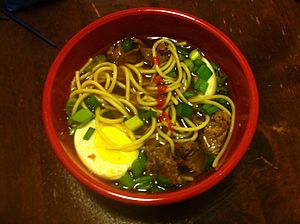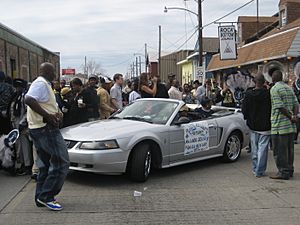Yaka mein facts for kids

Yaka mein served in a bowl
|
|
| Alternative names | Old sober, low-rent lo mein, Seventh ward mein |
|---|---|
| Type | Beef noodle soup Chinese noodle |
| Place of origin | United States |
| Main ingredients | Stewed beef (brisket), beef broth, spaghetti, hard-boiled egg, green onions |

Yaka mein (Ya-Ka-Mein, often pronounced Yakamee) is a type of beef noodle soup (simplified Chinese: 牛肉面; traditional Chinese: 牛肉麵) found in many Creole restaurants in New Orleans. It is also a type of Chinese wheat noodle.
The soup consists of stewed beef (such as brisket) in beef-based broth served on top of noodles and garnished with half a hard-boiled egg and chopped green onions. Cajun or Creole seasoning and chili powder are often added to the broth.
Culture and variations
Yaka mein is sometimes referred to as "Old Sober", as it is commonly prescribed by locals as a cure for hangovers. Vendors are common at New Orleans second lines, along with other settings including the New Orleans Jazz & Heritage Festival, alongside many other Creole and Cajun specialties. One of the major proponents of yaka mein since 2006 is Ms. Linda Green, who caters the dish at the Ogden Museum of Southern Art, JazzFest, Oak Street Po’Boy Fest, among other locations and cultural events in New Orleans. The soup is well loved by locals but not well known outside of the city and its surrounding region.
The dish is also found in Montreal, Canada, Norfolk, Virginia, Baltimore, Maryland, and Philadelphia, Pittsburgh, and Bellevue, Pennsylvania carry out restaurants. Some versions of Yaka Mein consists of thick wheat noodles (similar to udon) in a ketchup-based sauce or brown gravy, accompanied by thickly sliced onions, a hard-boiled egg, and fried noodles. Roast pork (char siu), chicken, and seafood can be added, with some restaurants including the option of pigs' feet.
Etymology
The phonetics of yaka mein is similar to the Cantonese pronunciation for "one order of noodles" (一個麵, Cantonese: jat1 go3 min6), a phrase commonly said by small restaurant waitstaffs to their kitchen to prepare an order of the restaurant's house noodle dish. However it is unclear if this is the origin of the name. The dish is spelled in innumerable ways, all with phonetic similarities. A non-comprehensive list of these spellings includes:
|
|
Origins
The origins of yaka mein are uncertain. Some sources, including the late New Orleans chef Leah Chase, have claimed that yaka mein originated in New Orleans's now extinct Chinatown, New Orleans that was established by Chinese immigrants brought from California during the mid-19th century to build the railroads between Houston and New Orleans and work in the sugar plantations of the American South. It was during this period that the Chinese noodle soup adapted to local Creole and Chinese clientele.
Regardless of its North American origins, by the 1920s yaka mein was already known in other parts of North America. In a 1927 article published in Maclean's magazine, the author indicated that "yet-ca mein" consisted of noodles or vermicelli boiled in rich stock, divided into individual bowls and garnished with sliced hard-boiled egg and sliced and chopped cooked meats. The author also indicated that other noodles dishes served in disparate fashions may also be collectively known as yet-ca mein.
In the movie Whipsaw, from 1935, starring Myrna Loy, a character in New Orleans places a phone order with a Chinese restaurant for, among other things, Yaka mein. This mention supports the origin story cited by Leah Chase.
Noodle type
Yaka mein is also referred to as a type of dried wheat Chinese noodles. In Canada Yet Ca Mein was introduced in the 1950s by Toronto-based Wing's Food Products and Montreal based parent Wing Noodle Company (Wing Lung or Wing Hing Lung).

